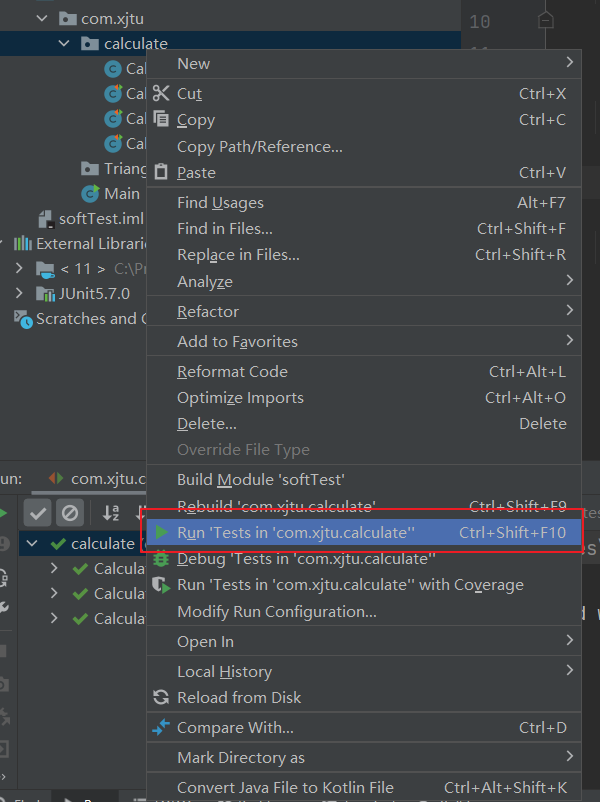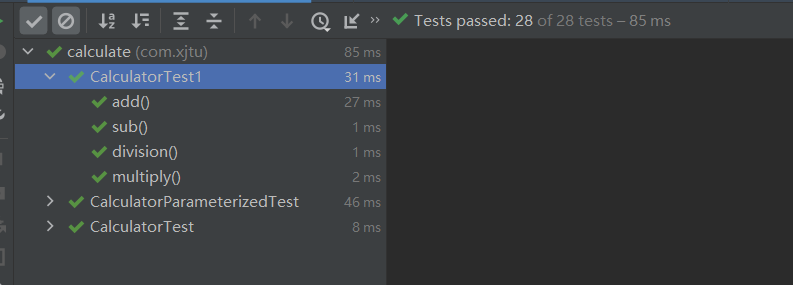If you don't know how idea creates Junit5 test project, you can see it This blog
Test process
Basic test
- Annotate the Test method @ Test
shortcoming
Each method can only be tested. To test multiple use cases in a use case, many methods need to be added, resulting in very bloated code, which is not recommended
package com.xjtu;
import org.junit.jupiter.api.AfterEach;
import org.junit.jupiter.api.BeforeEach;
import org.junit.jupiter.api.Test;
import static org.junit.jupiter.api.Assertions.assertEquals;
class CalculatorTest {
Calculator cal;
@BeforeEach
void setUp() {
cal = new Calculator();
}
@AfterEach
void tearDown() {
cal = null;
}
@Test
void add1() {
assertEquals(30, cal.add(10, 20));
}
@Test
void add2() {
assertEquals(0, cal.add(0, 0));
}
@Test
void add3() {
assertEquals(-10, cal.add(10, -20));
}
@Test
void sub1() {
assertEquals(-10, cal.sub(10, 20));
}
@Test
void sub2() {
assertEquals(10, cal.sub(20, 10));
}
@Test
void sub3() {
assertEquals(-20, cal.sub(0, 20));
}
@Test
void multiply1() {
assertEquals(20, cal.multiply(1, 20));
}
@Test
void multiply2() {
assertEquals(-20, cal.multiply(1, -20));
}
@Test
void multiply3() {
assertEquals(40, cal.multiply(-2, -20));
}
@Test
void division1() {
assertEquals(10, cal.division(20, 2));
}
@Test
void division2() {
assertEquals(-10, cal.division(20, -2));
}
@Test
void division3() {
assertEquals(0, cal.division(0, 2));
}
}
Parametric test
- Annotate the test method @ parametrizedtest
- Use the annotation @ xSource to formulate test data, where: x may be Value, Enum, Method, Csv, CsvFile, Arguments, etc
Add your own unique test data for each test method
package com.xjtu;
import org.junit.jupiter.api.AfterEach;
import org.junit.jupiter.api.BeforeEach;
import org.junit.jupiter.params.ParameterizedTest;
import org.junit.jupiter.params.aggregator.ArgumentsAccessor;
import org.junit.jupiter.params.provider.CsvSource;
import static org.junit.jupiter.api.Assertions.assertEquals;
class CalculatorParameterizedTest {
Calculator cal = new Calculator();
@BeforeEach
void setUp() {
}
@AfterEach
void tearDown() {
}
@ParameterizedTest
@CsvSource({"10,20,30", "0,0,0", "10,-20,-10"})
void add(ArgumentsAccessor args) {
assertEquals(args.getInteger(2), cal.add(args.getInteger(0), args.getInteger(1)));
}
@ParameterizedTest
@CsvSource({"10,20,-10", "20,10,10", "0,20,-20"})
void sub(ArgumentsAccessor args) {
assertEquals(args.getInteger(2), cal.sub(args.getInteger(0), args.getInteger(1)));
}
@ParameterizedTest
@CsvSource({"1,20,20", "1,-20,-20", "-2,-20,40"})
void multiply(ArgumentsAccessor args) {
assertEquals(args.getInteger(2), cal.multiply(args.getInteger(0), args.getInteger(1)));
}
@ParameterizedTest
@CsvSource({"20,2,10", "20,-2,-10", "0,2,0"})
void division(ArgumentsAccessor args) {
assertEquals(args.getInteger(2), cal.division(args.getInteger(0), args.getInteger(1)));
}
}
Use Kit
In the actual project, with the development of the project progress, there will be more and more unit test classes, but until now, we only run test classes one by one, which is certainly not feasible in the actual project practice. To solve this problem, JUnit provides a method to run test classes in batch, called test suite.
In this way, each time you need to verify the correctness of the system function, only one or several test suites can be executed.
Because JUnit 5 is used, I searched the Internet for a long time and didn't find the use method of the suite. After A blog You can right-click the package name and select run Tests in
This package, you can execute all test classes in the package

The final implementation results are as follows

JUnit Usage Summary
- Instead of initializing with the constructor of Testcase, use @ BeforeXxx and @ AfterXxx
- Don't rely on or assume the order of test run, because JUnit will use Vector to save test methods, so different platforms will take test data from Vector in different order, which is taken out and executed according to the alphabetical order under idea
- When integrating a test class, remember to call the classified @ BeforeXxx and @ AfterXxx
- Put the test code and working code together to compile and update synchronously
- Test classes and test methods should have consistent naming schemes. For example, add test after the class description to form a test class
- It is possible to use the assert and fail methods and exception handling methods provided by JUnit, which can make the code more brief